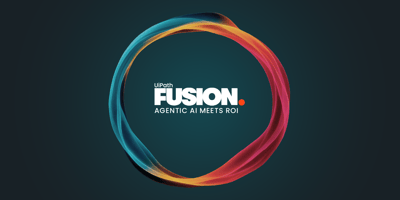Agentic AI meets ROI: why FUSION 2025 marks a defining moment
Share at:

FUSION 2025 was about one thing: proving that agentic AI delivers real ROI. For too long, the enterprise AI conversation has been dominated by hype, pilots that never scale, and confusion about what actually works. This year, we showed the difference between experiments and outcomes.
Why so many companies fail
Agentic AI is hard. The majority of projects stall because they lack a solid automation and orchestration foundation. Too often, AI and automation teams work in silos. Companies start with small pilots—usually chatbots—that never scale. Security and compliance concerns get in the way. Or executives never make it a top priority, leaving projects starved of attention and resources. Add in too few people capable of delivering at scale and a noisy vendor landscape, and the result is a 95% failure rate.
But the companies that succeed do things differently: they make it a CEO-level priority, go after the hardest use cases first, design for scale from day one, and focus on true orchestration—connecting agents, robots, and people across end-to-end workflows. They embrace an open ecosystem, choose partners who lean in, and make their workforce not just comfortable with AI, but excited about it.
From hype to ROI: how our customers are defining success
In a world driven by hype, we wanted UiPath FUSION to be about what really matters: customer success. That’s why our keynote was centered on the voices of our partners who are already proving what it takes to move beyond pilots and into production.
Watch the FUSION 2025 keynotes on demand.

CSL, one of the world’s leading healthcare companies, deliberately chose one of the hardest and most regulated challenges to automate: plasma donor eligibility. As Aaron White, Senior Director of Digital Products and Services, explained: “We went after the hardest one we could find. We knew that if we could pull this off, all the rest would be so much easier.”
The results speak for themselves: checks cut from minutes to four seconds, with over 98% accuracy—measurable ROI with life-changing impact on patient care.

At J.P. Morgan, Rash Bharda described what transformation looks like at true enterprise scale:
“If you start layering AI on traditional legacy infrastructure, you will not get the transformational changes you want. You really have to start thinking about how value flows, how decisions are made, and what outcomes we want to deliver to the client.”
It’s a reminder that agentic automation is not just about technology, but about reimagining the operating model, embedding governance, and managing cultural change.

Voya brought another lesson. CTO Rajat Kalia shared how their leadership embraced a mindset of progress over perfection: “We benchmarked a certain level of accuracy, and when we weren’t quite there, my team wanted to push the launch. But we said no—we’re going to deploy, and we’ll continue to tweak it in production. Within weeks we went from the 60s to 90% accuracy.”
Their CEO made agentic AI a company-wide mandate, ensuring adoption was business-led, not just IT-led.

And Capgemini showed what it means to lead as both a partner and a customer. Oliver Pfeil, CEO of Capgemini Business Services, described their own journey: “We developed three intelligent agents to automate query resolution across HR. A process that once took days now takes minutes. The difference is orchestration—integrating, monitoring, and scaling across robots, agents, and humans.”
For their 360,000 employees, that means a transformed employee experience, and for their clients, a model for how to scale agentic automation responsibly.
These stories prove that the 5% of companies who succeed with agentic AI share a common playbook: CEO support, the courage to address the hardest—and most impactful—use case, scale in mind, orchestration at the core, open ecosystems, and workforce engagement.
UiPath itself holds to the same standard. As customer zero, we’ve already automated thousands of hours of licensing, quoting, and cash reconciliation, saving millions while freeing our teams for higher-value work. Across 4,000 employees, we’ve surfaced more than 550 ideas for agentic automation. Our goal is simple: to grow without growing headcount, and to be the best proof point of what’s possible with our platform.
Building the backbone of the agentic enterprise
At FUSION, we introduced the next wave of UiPath innovation designed to make that orchestration real. ScreenPlay allows you to build automations in natural language, combining large action models with our industry-leading automation to handle scenarios once out of reach.
Project Delegate brings an enterprise-grade AI desktop agent to every professional, blending intelligence with governance so work simply gets done.
UiPath Agents expand the ways teams can build—from low-code to conversational to pro-code—with new debugging, templates, and reusable components.
And UPath Maestro™ continues to evolve as the ‘conductor’ of the enterprise, now offering industry-specific case management and process apps that accelerate time to value.
An open, flexible ecosystem
We also announced deeper collaboration with OpenAI, NVIDIA, Google, Snowflake, and Microsoft. These collaborations reflect our open and flexible approach: no lock-in, just choice. Whether you need GPU acceleration for sensitive workloads, conversational agents with multilingual empathy, or seamless links between insights and action, our ecosystem gives customers the flexibility to orchestrate without compromise.
ROI equals orchestration
FUSION 2025 proved that the future of work is no longer a promise. It’s here. And it is orchestrated with UiPath. When you connect AI agents, robots, people, and systems through Maestro, you move from pilots to production, from hype to outcomes, and from vision to measurable ROI.
The defining moment for agentic automation is here. Together, we are proving that the future of work is not measured in hype, but in ROI.
Watch the FUSION keynotes on demand.
We've also put together the best of FUSION into a three-volume series. Register now to get The Best Bits delivered straight to your inbox.

Founder and CEO, UiPath
Get articles from automation experts in your inbox
SubscribeGet articles from automation experts in your inbox
Sign up today and we'll email you the newest articles every week.
Thank you for subscribing!
Thank you for subscribing! Each week, we'll send the best automation blog posts straight to your inbox.



